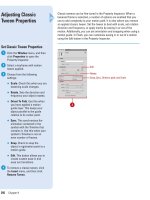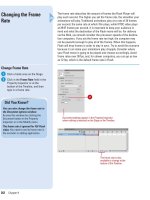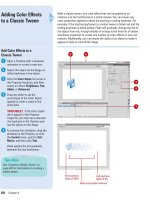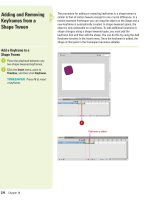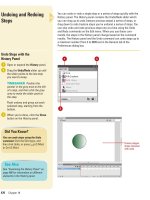Tài liệu Thiết kế flash với flash cs5 part 52 pdf
Bạn đang xem bản rút gọn của tài liệu. Xem và tải ngay bản đầy đủ của tài liệu tại đây (547.46 KB, 5 trang )
ptg
Chapter 13 Working with Video 331
While placing a video file directly onto the Stage may be an easy way
to bring a video file into a Flash movie, the best way to control video is
to first place it into a movie clip, and then drag the movie clip onto the
Stage. That gives you control of the clip with two Timelines: the
Timeline on the Stage, and the Timeline of the movie clip.
Using Movie Clips
with Video Files
Use Movie Clips with
Video Files
Click the Window menu, and then
click Library to open the Library
panel.
Click the Insert menu, and then
click New Symbol.
Name the new symbol.
Click Ty pe list arrow, and then
click Movie Clip.
Click OK.
Drag a video file from the Library
into the movie clip Library.
Click Yes when Flash instructs you
as to how many frames the video
file will occupy in the movie clip.
Return to the current scene by
clicking the Scene button, located
in the upper-left corner of the
Flash window.
Click the Insert Layer button, and
name the new layer video_1.
Select the new layer.
Drag the movie clip from the
Library onto the Stage.
The movie clip occupies a single
frame.
Click the Control menu, point to
Test Movie, and then click Test.
12
11
10
9
8
7
6
5
4
3
2
1
5
3
6
11
9
10
4
8
From the Library of Wow! eBook
ptg
332 Chapter 13
A cue point is a marked moment in time within a video clip. Cue points
enable you to access different segments of a video clip. With Flash
video, you can create and manage ActionScript cue points in the
Properties panel (New!). You can add or delete a cue point, rename a
cue point, adjust the time, and add or delete ActionScript parameters. If
you want to reuse existing ActionScript cue points, you can also import
and export them in the XML file format using the Import ActionScript
Cue Point or Export ActionScript Cue Point buttons.
Adding Cue Points to
a Video
Work with Cue Points in a Video
Open a Flash FLA document that
contains one or more video files in
the Library or use the Video Import
Wizard.
Select the video.
Click the Window menu, and then
click Properties to open the
Properties panel.
Click the Cue Points arrow to
expand the panel.
To work wi th Acti onScript cu e
points, do any of the following:
◆ Find a Cue Point. Enter a
keyword in the Search box, and
then press Enter (Win) or
Return (Mac).
◆ To clear the search , c lick
the Close button in the
Search box.
◆ Add a Cue Point. Use the
playback controls to position
the video where you want to
create a cue point, and then
click the Add ActionScript Cue
Point button.
◆ Delete a Cue Point. Select the
cue point, and then click the
Delete ActionScript Cue Point
button.
◆ Rename a Cue Point. Click the
cue point name to select it,
rename it, and then press Enter
(Win) or Return (Mac).
5
4
3
2
1
2
3
4
Playback
controls
From the Library of Wow! eBook
ptg
Chapter 13 Working with Video 333
To add o r de le te Acti on Scri pt
parameters, do any of the
following:
◆ Add Parameter. Click the Add
Cue Point Parameter button.
Click the parameter name or
value to change them.
◆ Delete parameter. Select the
the parameter, and then click
the Delete Cue Point Parameter
button.
To export or import Ac tion Sc ript
cue points, do any of the following:
◆ Export Cue Points. Click the
Export Cue Points button,
specify a filename and location,
and then click Save.
The exported file also includes
any navigation and event cue
points which are embedded in
the video
◆ Import Cue Points. Click the
Import Cue Points button,
select the cue points XML file,
and then click Open.
7
6
5
6
7
Import
Cue point controls
See Also
See “Working with the Video Encoder”
on page 340 for more information on
working with encoded cue points.
Did You Know?
ActionScript cue points are different
than encoded cue points.
Encoded cue
points are ones you add when encod-
ing video with Adobe Media Encoder.
From the Library of Wow! eBook
ptg
334 Chapter 13
Playing a video file inside a Flash movie is one thing, controlling the
movie, or better yet, letting your visitors control the movie is something
quite different. Control of a movie requires knowledge of Flash's
ActionScript language. ActionScript is a control language that instructs
Flash what to do, and when to do it. For example, you could create an
ActionScript that instructs Flash to play or stop a movie, or you could
add buttons to move the video backward or forward, one frame at a
time. One way to display video in a Flash Movie is to drag it directly
from the Library to the Timeline. Once the video is on the Timeline,
ActionScripts can be created to start and stop the video. Since you're
using the active document's Timeline to control the video, any other
layers containing animation sequences on the Timeline will stop and
start along with the video.
Using Video with
ActionScript
Control Video from the Timeline
Create or open a Flash document,
create a new layer to hold the
video file, and then select the
layer.
Drag the video file from the Library
to the Stage.
Create a new layer to hold the
navigation buttons, and then select
the layer.
Drag the Play, Stop, and Rewind
buttons into the Navigation layer
from the Library, and then place
them underneath the video.
Click the Window menu, and then
click Actions to open the Actions
panel.
To display sc ript in g lang uage
commands for the scripting
language you want to use, click
the Language button, and then
select the language you want.
6
5
4
3
2
1
Did You Know?
You can check the syntax of any script
with the click of a button.
Click the
Check Syntax button, located at the top
of the Actions panel, and Flash will
check the syntax of the script.
4
3
2
1
6
7
AS 3.0
From the Library of Wow! eBook
ptg
Chapter 13 Working with Video 335
Do either of the following
depending on the ActionScript
version:
◆ ActionScript 2.0. Select the
Play, Stop, and Rewind buttons
individually, and then enter the
ActionScript 2.0 script as
shown in the illustration.
◆ ActionScript 3.0. Click Frame 1
in a layer, and then enter the
ActionScript 3.0 script as
shown in the illustration.
IMPORTANT
ActionScript is a
relatively easy language to learn,
but it is also a very unforgiving
language. For example, the
gotoAndStop script must be
written exactly as shown,
including the capital "A" and "S".
While ActionScripting, remember
to keep an eye on syntax.
Click the Control menu, point to
Test Movie, and then click Test.
IMPORTANT
Although working
with embedded video is a common
practice, large video files can
cause audio sync problems when
the file is published and played.
It's always wise to thoroughly test
your published documents.
8
7
7
Did You Know?
Flash contains several sets of pre-
designed buttons.
Click the Window
menu, point to Common Libraries, and
then click Buttons. Flash's button
Library contains folders with dozens of
buttons, including arcade buttons and
buttons for controlling a Flash movie.
AS 2.0
AS 2.0 - Stop
AS 2.0 - Rewind
From the Library of Wow! eBook



